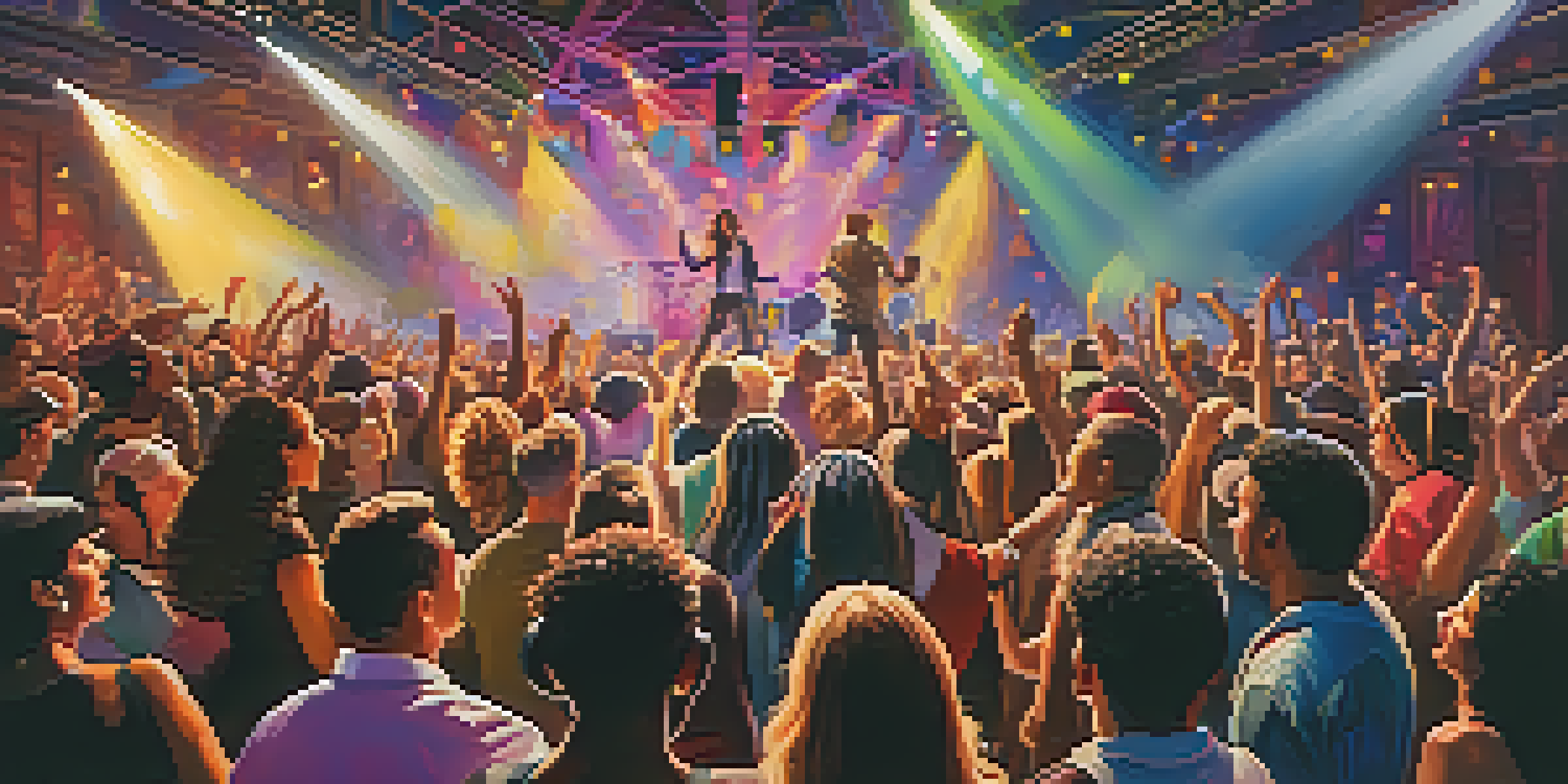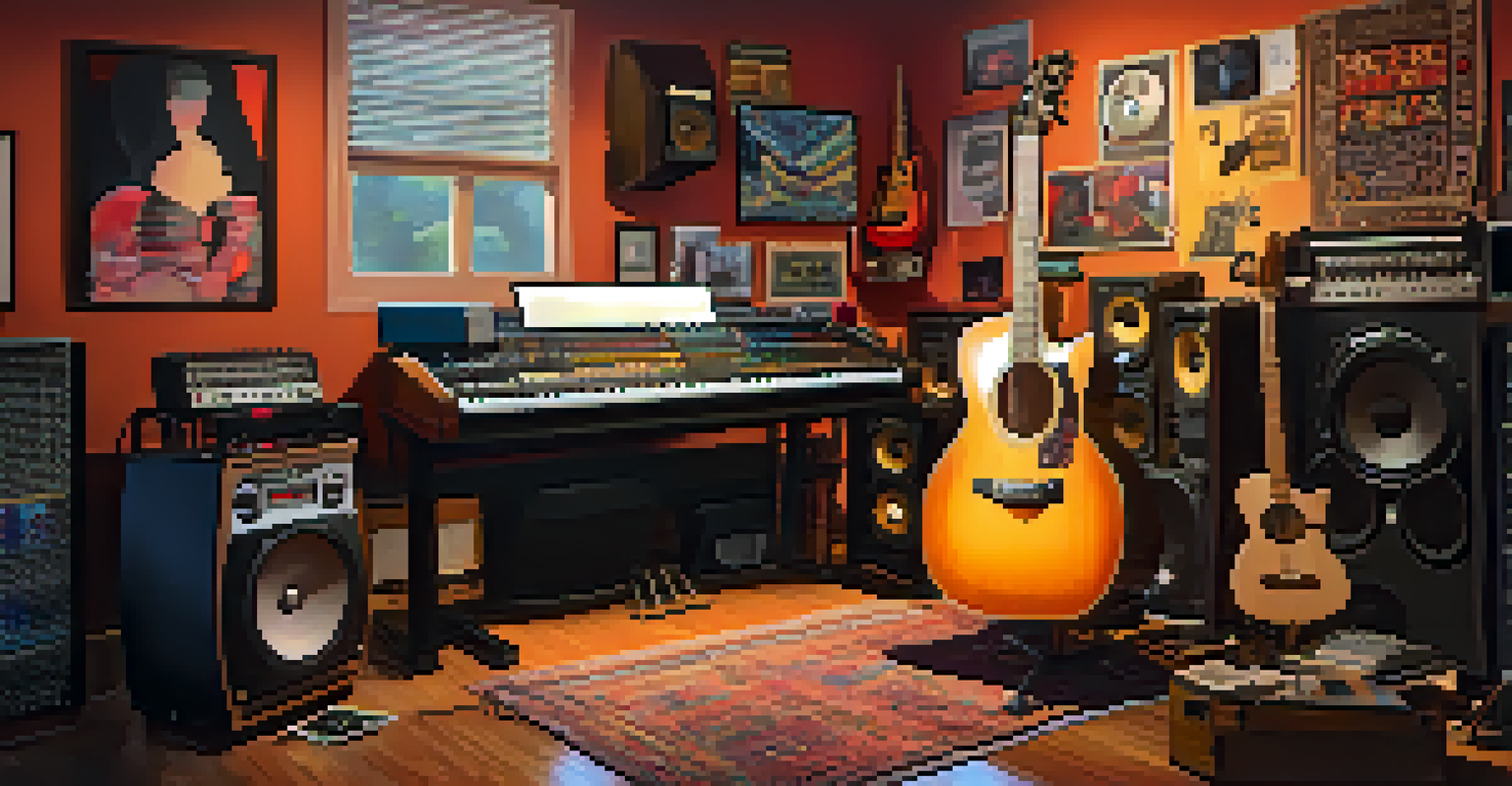The Impact of Gender on Audience Reception of Music

Understanding Gender Roles in Music Consumption
Gender roles have historically influenced how individuals engage with music. For instance, societal expectations often dictate which genres are considered 'masculine' or 'feminine.' This can lead to men gravitating towards rock or hip-hop while women may prefer pop or country. However, these trends are not absolute and can change with cultural shifts.
Music is a powerful tool for expression, and it transcends gender boundaries.
As we've seen with the rise of female artists in traditionally male-dominated genres, like rock, the lines are starting to blur. Artists like Joan Jett and more recently, Halsey, have challenged these norms by appealing to a diverse audience. This not only diversifies their fan base but also encourages listeners to explore beyond traditional gender boundaries.
Ultimately, understanding these roles is crucial for artists and marketers alike. It allows them to tailor their messages and outreach efforts, ensuring they resonate with a broader audience rather than sticking to outdated stereotypes.
The Influence of Gender on Music Preferences
Research indicates that gender can significantly influence music preferences. Studies have shown that men often prefer music with higher energy and aggression, while women may gravitate towards more melodic and emotional tracks. This isn't to say that all men and women fit neatly into these categories, but trends do provide insight into general preferences.

For instance, pop music, which often emphasizes catchy melodies and emotional themes, tends to have a larger female audience. In contrast, genres like heavy metal or hard rock frequently attract more male listeners. These preferences can be linked to societal norms and the way music is marketed to different genders.
Gender Roles Shape Music Choices
Societal expectations often dictate music preferences, leading men and women to gravitate towards different genres.
Understanding these differences can help artists and producers create more targeted content. By acknowledging and embracing these preferences, they can engage with audiences more effectively and foster a deeper connection with their fans.
Gender and the Emotional Connection to Music
Emotional connections to music can vary widely based on gender. Research suggests that women often express a stronger emotional response to music, which can influence their music choices. For example, women may be drawn to lyrics that tell a story or evoke deep feelings, making ballads particularly appealing.
The future of music is inclusive, allowing every voice to be heard regardless of gender identity.
On the other hand, men might connect with music through themes of power and triumph, which are prevalent in genres like hip-hop and rock. This difference in emotional engagement can shape the way each gender experiences live performances and music consumption at home.
By recognizing these emotional nuances, artists can craft their music to resonate more profoundly with their target audience. This could mean emphasizing lyrical storytelling for women or incorporating powerful beats for men, ultimately enhancing listener engagement.
The Role of Marketing in Gender Perception
Marketing strategies play a pivotal role in shaping gender perception in music. Historically, the music industry has often marketed artists based on gender stereotypes, which can reinforce traditional norms. For example, female artists may be marketed more on their appearance, while male artists often focus on their talent and charisma.
This disparity in marketing can affect how audiences perceive artists and their music. When a female artist is portrayed primarily as a 'pop princess,' it may overshadow her musical capabilities, leading to a lack of respect in certain circles. Conversely, male artists may be given more leeway to explore various genres without being confined to a single image.
Emotional Connections Vary by Gender
Research suggests that women typically respond more emotionally to music, influencing their preferences for lyrical storytelling.
As the industry evolves, there is a growing recognition of the need for more balanced marketing approaches. Brands that celebrate diversity and authenticity can resonate more with audiences, fostering a more inclusive and supportive music culture.
Live Performances: Gender Dynamics in Concerts
The dynamics of live performances can also reveal how gender impacts audience reception. In many cases, female artists face different expectations and experiences on stage compared to their male counterparts. For instance, female performers might encounter more scrutiny regarding their appearance, while male artists are often judged based on their performance skills.
This disparity can create an uneven playing field, affecting how audiences perceive and engage with the performance. Female artists may feel pressured to conform to certain standards, which can influence their stage presence and overall performance. On the flip side, male artists often enjoy more freedom in their artistic expression.
Recognizing these dynamics is crucial for promoting equality in the music industry. By fostering an environment where all artists can perform authentically, the audience can enjoy a richer, more diverse musical experience.
Gender Identity and Music Genres
Gender identity plays a significant role in how individuals relate to different music genres. In recent years, there has been a notable increase in artists who identify as LGBTQ+, which has helped diversify the music landscape. This shift has encouraged audiences to embrace a wider array of genres that challenge traditional gender norms.
For example, artists like Lil Nas X and Sam Smith have not only achieved commercial success but have also opened doors for discussions around gender identity and expression in music. Their influence allows listeners to feel more comfortable exploring genres that may not align with traditional gender expectations.
Diversity is Changing Music Marketing
The music industry is increasingly recognizing the need for balanced marketing approaches that celebrate diversity and authenticity.
This evolution in the music industry highlights the importance of inclusivity in shaping audience reception. By embracing a variety of identities and expressions, artists can connect with broader audiences, fostering a sense of community and acceptance.
Future Trends: Gender and Music Consumption
As society continues to evolve, so too does the relationship between gender and music consumption. The rise of digital platforms has democratized music access, allowing listeners to explore genres independent of societal norms. This shift is particularly significant for younger generations who are more open to diverse musical influences.
Moreover, the emphasis on representation and inclusivity is reshaping the music industry landscape. More labels are prioritizing diverse talent, which can lead to a richer variety of music that appeals to wider audiences. This trend could potentially blur the lines of traditional gender preferences, allowing for a more fluid engagement with music.

Looking ahead, the intersection of gender and music will likely become even more complex. As artists continue to challenge norms and redefine genres, audiences will have the opportunity to connect with music in ways that reflect their identities and experiences.